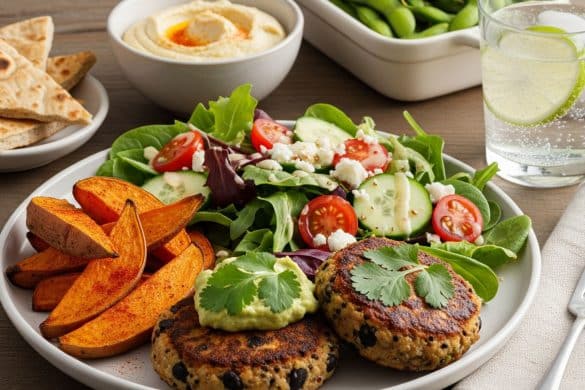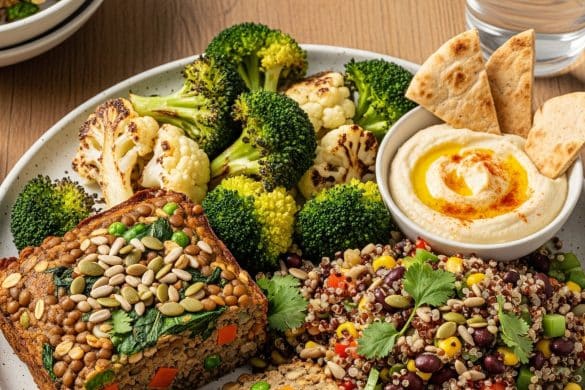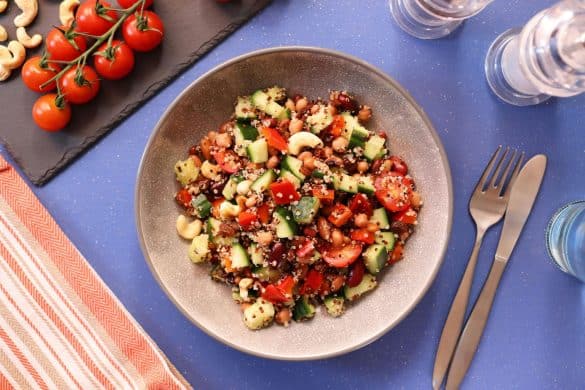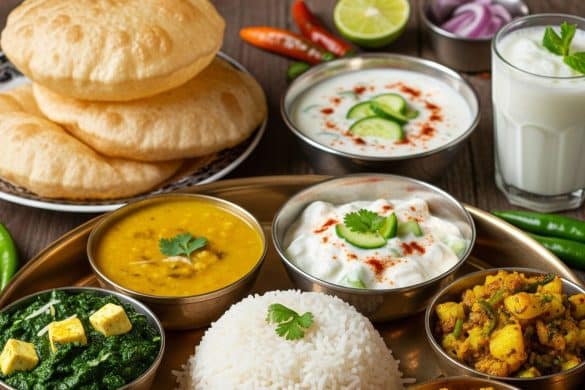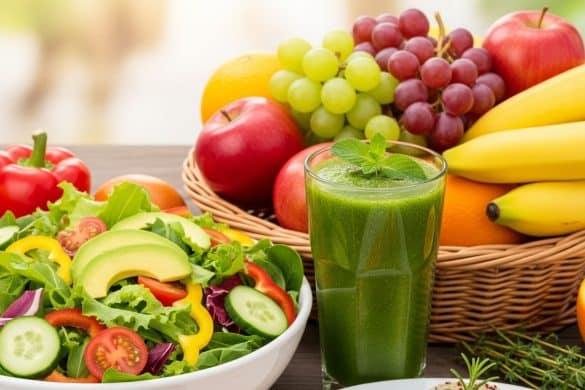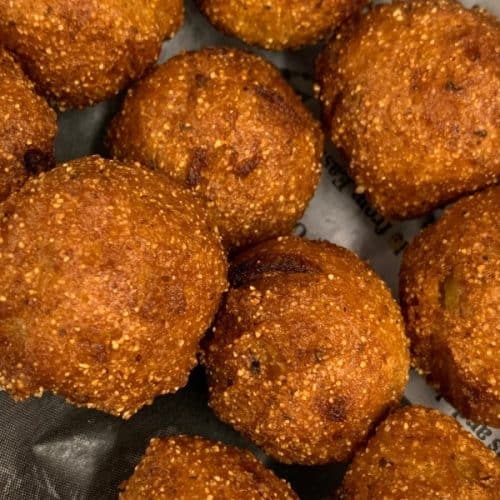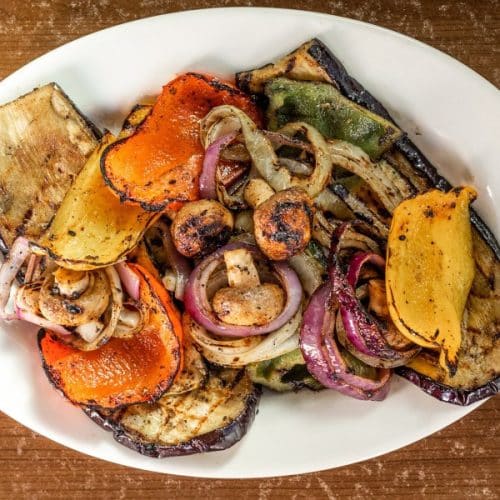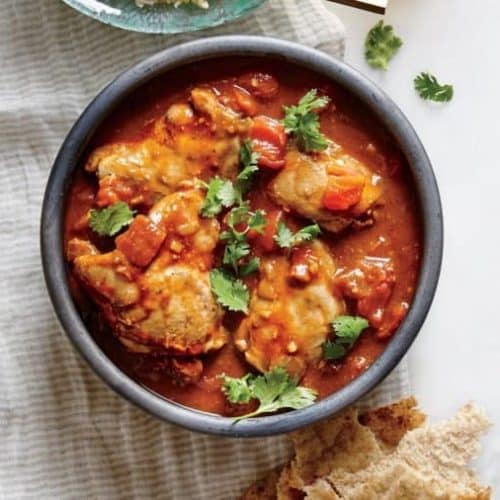Nestled in the North East, the state of Arunachal Pradesh boasts incredible cultural diversity reflected in its distinctive cuisine. The state’s food bears the stamp of numerous tribes that call this region home, each lending their unique flavours and cooking methods. Much like the scenic beauty and cultural richness, the culinary heritage of Arunachal Pradesh also stands out, securing its place as a key focus of Indian gastronomic tourism.
The variety in Arunachal Pradesh’s cuisine is directly tied to the topography and the availability of ingredients. From bamboo shoots and leafy greens to an assortment of meats, the food is typically boiled or smoked, embodying the state’s preference for healthier cooking techniques over deep frying. Whether you savour meat-based dishes, crave vegetarian delicacies or have a penchant for tasty side dishes, the Arunachali cuisine serves up something for everyone, offering a gastronomical journey as exciting as exploring the state itself.
10 Unique dishes of Arunachal Pradesh
When you tour Arunachal Pradesh, it’s not just about the picturesque landscapes or rich cultural heritage; it’s also about savouring mouth-watering culinary delights that the state offers. From the famous Pika Pila and Lukter to lesser-known dishes like Pehak and Chura Sabzi, Arunachali cuisine is sure to tantalise your taste buds. Besides, the ideal pairing of local rice beer ‘Apong’ with most dishes enhances the gastronomical experience. Let’s delve into the details of these unique dishes and get a peek into their preparation and rich flavours.
1. Pika Pila
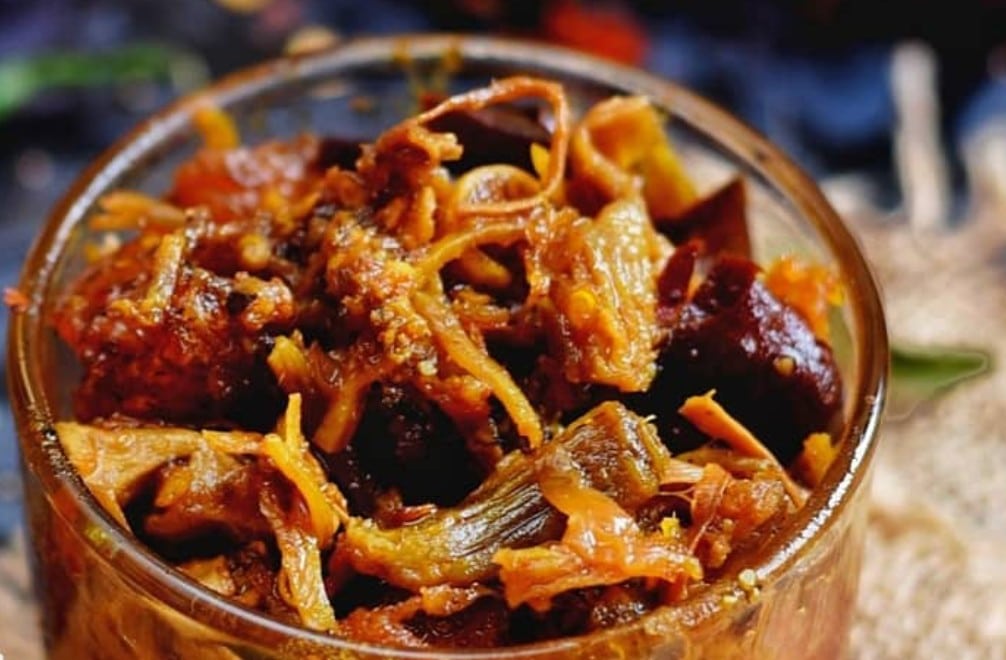
Image of Pika Pila
One of the highlight dishes in Arunachal cuisine is Pika Pila, a unique pickle that beautifully brings together flavours from two primary ingredients – bamboo shoots and pork fat. This side dish has been an integral part of local meals for generations, originally crafted by the native Apatani tribe.
Though hot, Pika Pila is not overly spicy, making it an enjoyable accompaniment to many main meals. The bamboo shoot lends it a delicate flavour, while the pork fat offers a delightful richness. This harmony of flavours, elevated by King Chilly’s heat, represents the rustic charm of Arunachali cuisine in a bite. With its well-rounded flavours, Pika Pila is a must-try when you’re exploring the culinary wonders of Arunachal Pradesh.
Recipe
- Wash and chop bamboo shoots into small pieces.
- Cook the bamboo shoots in boiling water to reduce bitterness.
- Add fermented mustard seeds and blend into a paste.
- Mix the bamboo shoots with the mustard seed paste.
- Heat oil in a pan, add spices and the mixture, then cook until well-blended.
2. Lukter
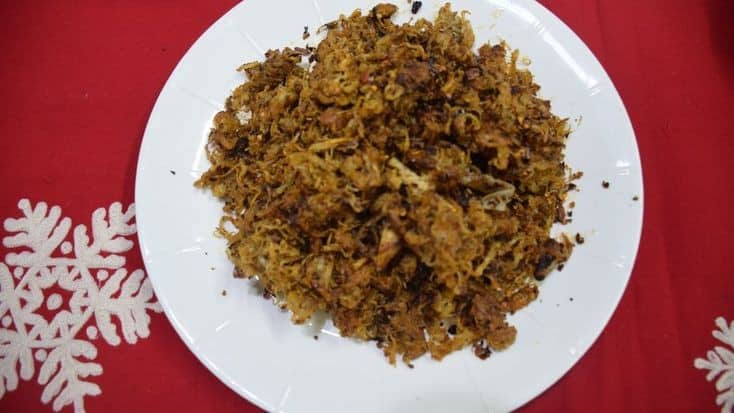
Image of Lukter
If your palate craves a touch of the exotic, Lukter, an Arunachali favourite, is sure to captivate your taste buds. A popular dish and a tempting combination of dry meat and chilli flakes derived from King Chilly or Bhut Jolokia, Lukter stands as a testament to the Arunachali inclination towards healthier, less oil-dense food preparations.
Dry meat, specifically beef, is a widely consumed ingredient in Arunachal Pradesh and is the star element in Lukter. The dish emits an alluring aroma courtesy of the smoked beef, while its taste is a robust blend of spicy and savoury notes. Owing thus to the celebrated Bhut Jolokia chilli, Lukter packs a fiery punch, making it a favourite among spice lovers.
Traditionally, Lukter is served as a side dish with rice, contributing a robust flavour profile that beautifully complements the mellow taste of the staple grain. Its warming characteristics make it ideal for consumption during the cold winter months in Tawang. The burst of flavours combined with its nutrition quotient, courtesy of the protein-rich dry meat, makes Lukter a much sought-after delicacy in Arunachal Pradesh.
Recipe
- Roast dry red chillies and crush them into flakes.
- Heat a pan, and dry roast thinly sliced beef strips until crispy.
- Mix the roasted beef with the chilli flakes.
- Add salt and a touch of oil, if needed, for a flavorful finish.
3. Pehak
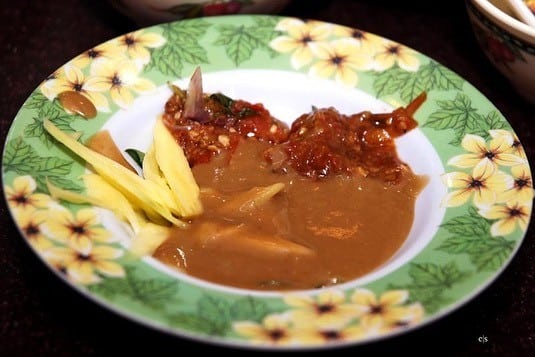
Image of Pehak
Another quintessential Arunachali main delicacy is Pehak, a spicy chutney that compels you to explore more of Arunachal’s gastronomic pursuits. Pehak, like many other local dishes, highlights the use of fermented soya bean and King Chilly.
Rich and filled with aromatic ingredients, Pehak amplifies the overall dining experience when served with steamed rice. Despite its spicy heat, courtesy of Bhut Jolokia or the King Chilly, it flaunts a lingering umami-led savoury note that will tickle your palate in every spoonful. This tasteful blend of hot and tangy flavours seems to represent the state’s vibrant tribal culture quite aptly.
Pehak subtly reflects the simple yet impactful life of Arunachal’s tribes. Through its balanced yet striking flavours, it showcases the brilliance of using locally sourced ingredients in traditional cuisine.
Recipe
- Roast fermented soybeans until aromatic and mash them into a coarse paste.
- Chop king chilli (bhut jolokia) finely.
- Mix the chilli with the soybean paste.
- Adjust seasoning and serve as a condiment with steamed rice.
4. Chura Sabzi
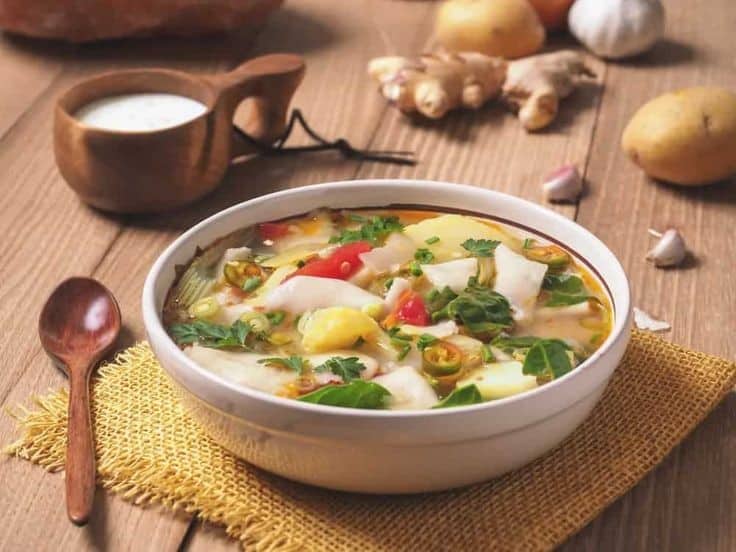
Image of Chura Sabzi
Chura Sabzi is an exquisite curry from Arunachal Pradesh that captivates with its creamy texture and mildly spicy taste. It centres on fermented cheese, extending the state’s tradition of using dairy products in their cuisine.
The key ingredient can be cheese derived from either cow’s milk or yak milk, bringing a creamy richness to the dish. Flakes and pieces of King Chilly add a subtle spice that resonates well with the mellow cheese flavour. The amalgamation of these ingredients results in a curry that’s simply irresistible when served with hot rice.
With its warm and comforting notes, Chura Sabzi is sure to win the hearts of both vegetarian and non-vegetarian food lovers during their visit to Arunachal Pradesh.
Recipe
- Wash and boil soft cheese (chura) in water until smooth.
- Heat oil in a pan, sauté chopped green chillies and tomatoes.
- Add the boiled cheese and cook until the mixture thickens.
- Season with salt and serve hot.
5. Khazi
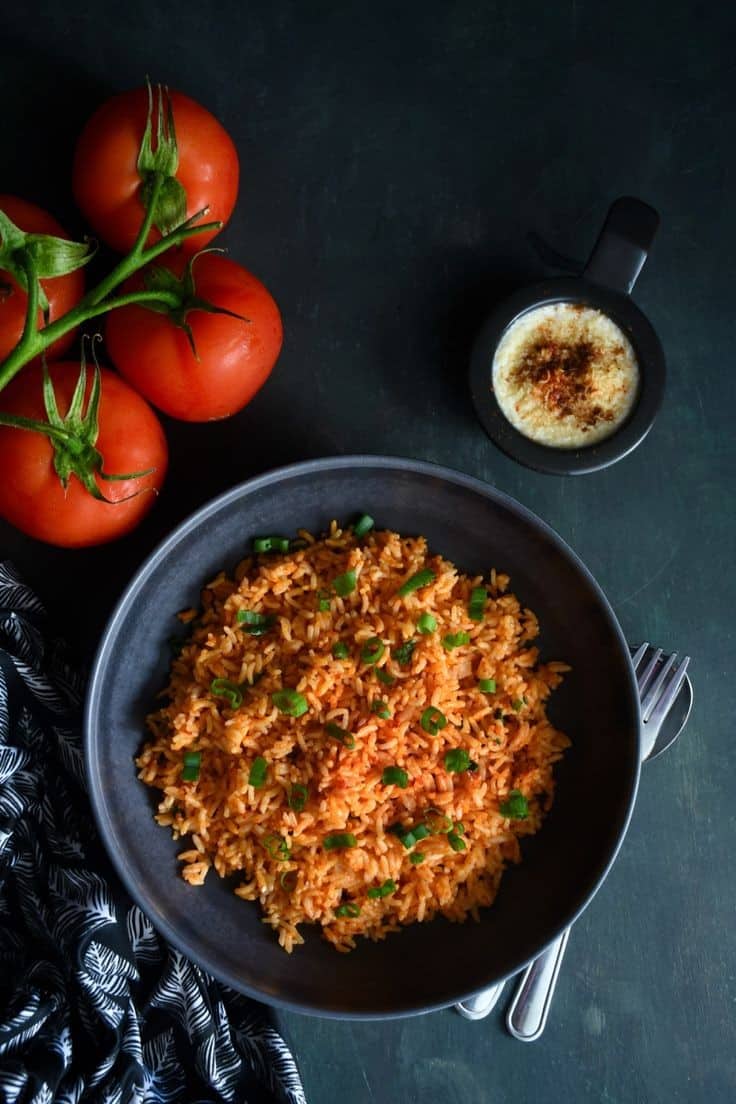
Image of Khazi
Khazi is a traditional rice-based delicacy from Arunachal Pradesh, known for its rich flavours and cultural significance. This aromatic dish is prepared by cooking rice with an assortment of local herbs, spices, and sometimes meat or vegetables, depending on regional variations. A
defining characteristic of Khazi is the use of Indigenous ingredients like bamboo shoots, wild herbs, and fermented soybeans, which impart a distinct earthy and tangy flavour. Meat lovers often savour the addition of smoked pork, which adds depth and a smoky aroma, while vegetarian versions highlight the freshness of local greens and vegetables.
Recipe
- Wash and soak rice for 30 minutes.
- Heat oil in a pot, sauté aromatic spices and herbs until fragrant.
- Add rice and mix well to coat the grains with the spices.
- Pour water or stock, cover, and cook until the rice is tender.
- Add smoked pork or vegetables for flavour, and simmer briefly before serving.
6. Wungwut Ngam
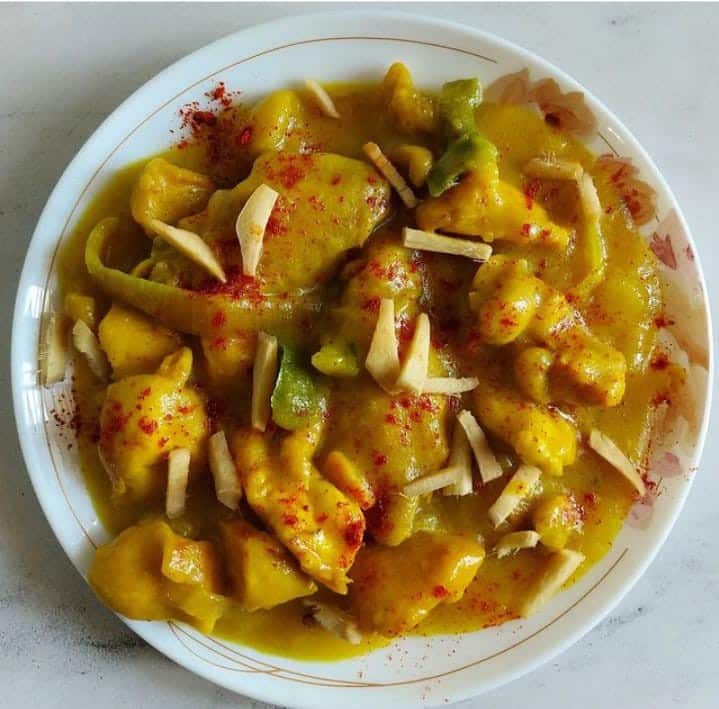
Image of Wungwut Ngam
While you journey through the diverse culinary landscape of Arunachal Pradesh, a dish you absolutely cannot miss is Wungwut Ngam. This delicacy, prepared with chicken, indigenous spices, and rice powder, undoubtedly stands as one of the most surprising offerings in the state’s cuisine.
The local herbs lend a delightful aroma and a distinctive flavour to the dish. Wungwut Ngam carries the ethos of the homely and yet exotic cooking styles of Arunachal Pradesh. Sink your teeth into the rustic yet delightful Wungwut Ngam on your next trip to Arunachal Pradesh for an unforgettable taste experience.
Recipe
- Marinate chicken pieces with turmeric, salt, and a touch of mustard oil.
- In a pan, fry onions until golden, then add the chicken and cook until browned.
- Add water and simmer the chicken until tender.
- Garnish with fresh green herbs and serve hot.
7. Oying
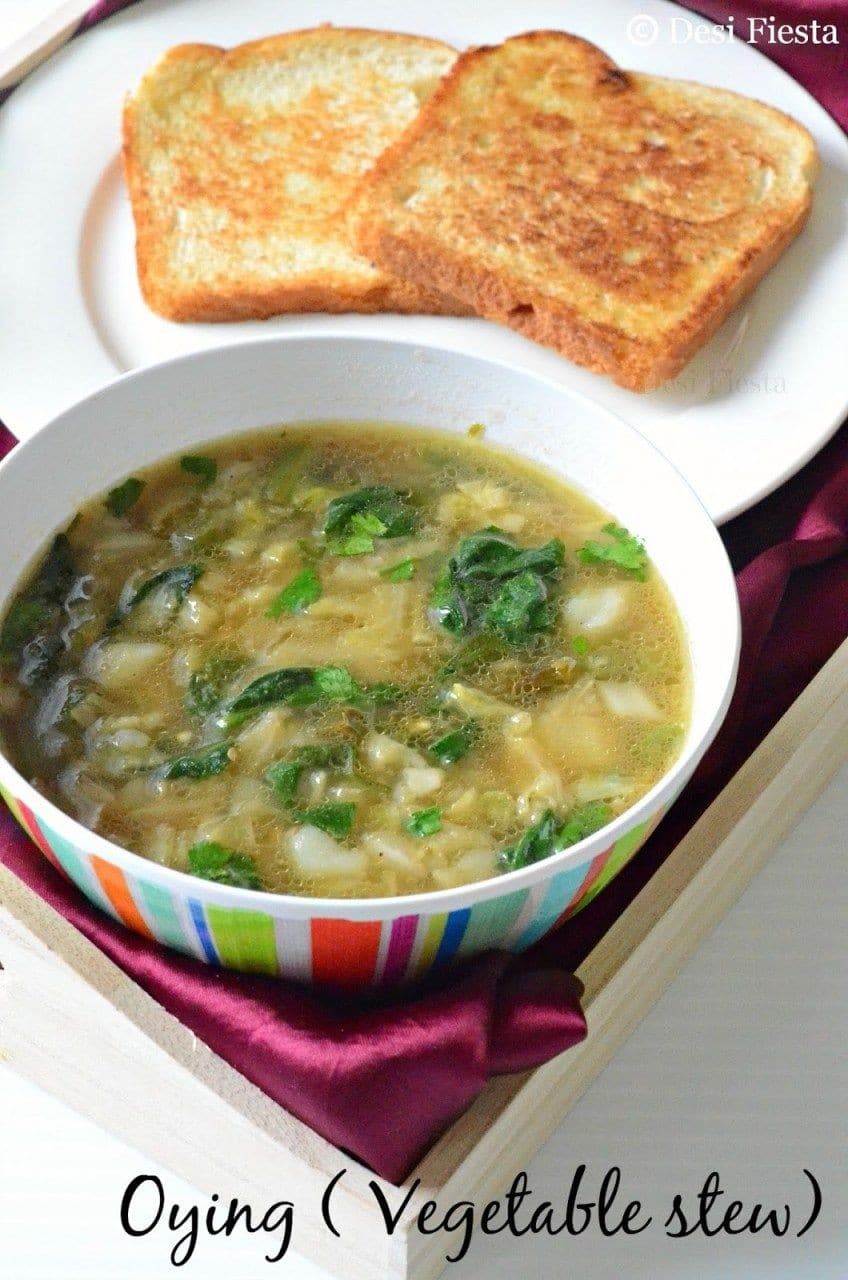
Image of Oying
For the ardent fans of stew, Arunachal Pradesh offers Oying, a traditional dish that seamlessly blends in fresh veggies and a slew of local spices. Rooted in ancient tribal culinary practices, this delicacy was often prepared during times of war, when lighting a fire could potentially alert the enemy.
Today, Oying stands as a cherished part of the state’s cuisine, bestowing upon it a distinctive edge. The true charm of this dish lies in the freshness of the vegetables, which are boiled and allowed to be cooked in their own juices. Served usually along with rice, Oying encapsulates the traditional roots and contemporary tastes of Arunachal’s food culture.
Recipe
- Wash, peel, and dice potatoes into ½-inch cubes.
- Trim and slice beans into small pieces.
- Wash and shred cabbage and greens.
- Slice green chilies and mince ginger.
- Bring 2 cups of water to a boil, add potatoes, and simmer for 5 minutes with a pinch of salt.
- Add cabbage, greens, and beans, then simmer for 20 minutes until all vegetables are tender.
- Add salt to taste and green chilies; boil for 2 minutes.
- Stir in minced ginger off the heat, cover for 5 minutes, and serve hot with rice.
8. Papuk
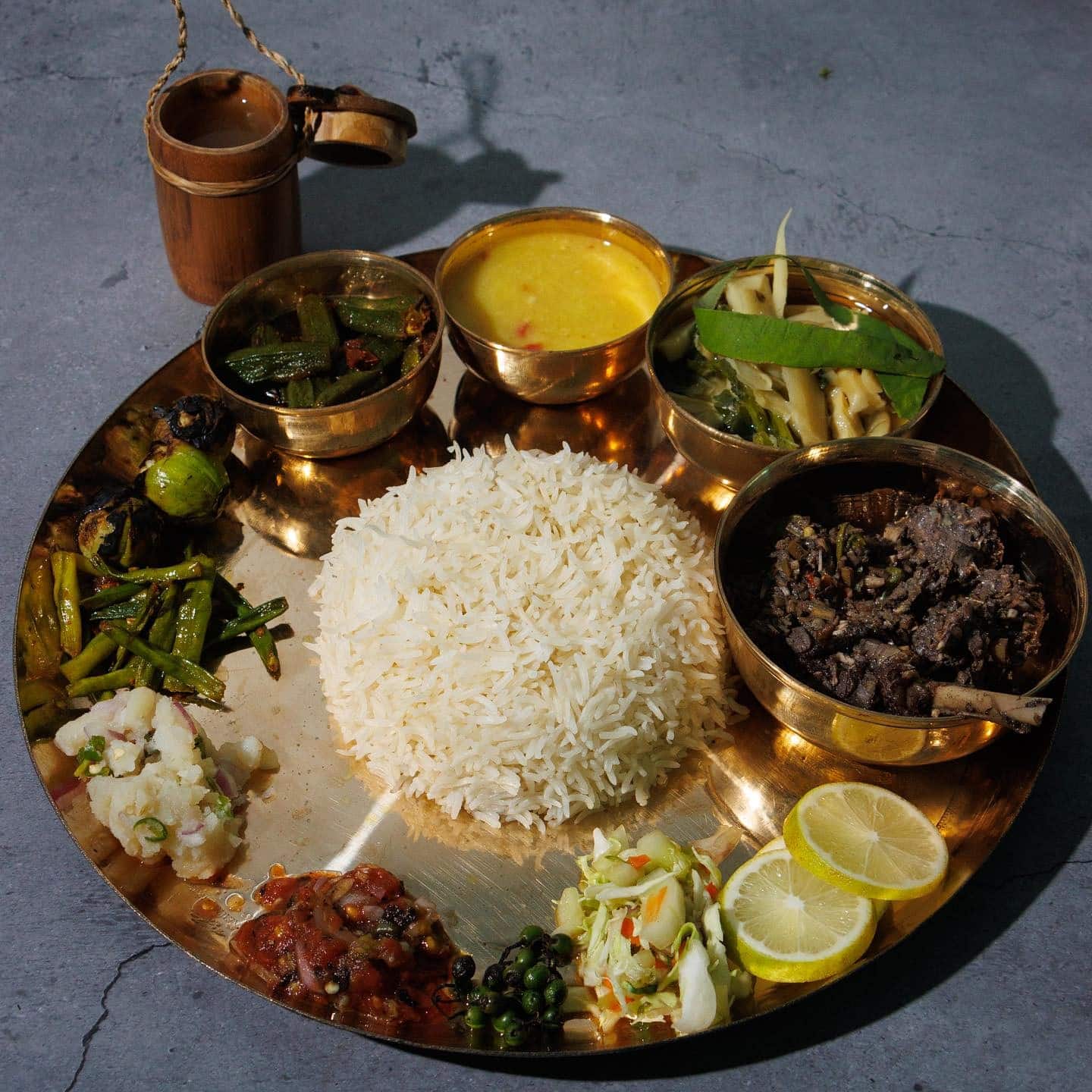
Image of Papuk Thali
Another gem from the diverse culinary repertoire of Arunachal Pradesh is Papuk. This appetising treat is prepared with fermented bamboo shoots, chicken, banana flowers, and red chillies, showcasing the locals’ ingenious use of regionally available ingredients.
Papuk can be savoured as a standalone dish or paired with sticky rice, offering an incredible juxtaposition of textures and flavours. What sets Papuk apart is its perfect blend of simplicity and sophistication – commonplace ingredients transformed into a dish that takes your taste buds on an adventure.
Every bite of Papuk imparts a combination of smoky, spicy, and sweet undertones, perfectly embodying the essence of Arunachali cuisine. When you find yourself in the beautiful realms of Arunachal Pradesh, be sure to indulge in the unforgettable flavour journey that Papuk promises.
Recipe
- Slice and boil wild vegetables until tender.
- Heat mustard oil in a pan, add garlic, and sauté until aromatic.
- Add the boiled vegetables and stir-fry lightly.
- Season with salt and serve as a side dish with rice.
9. Momos
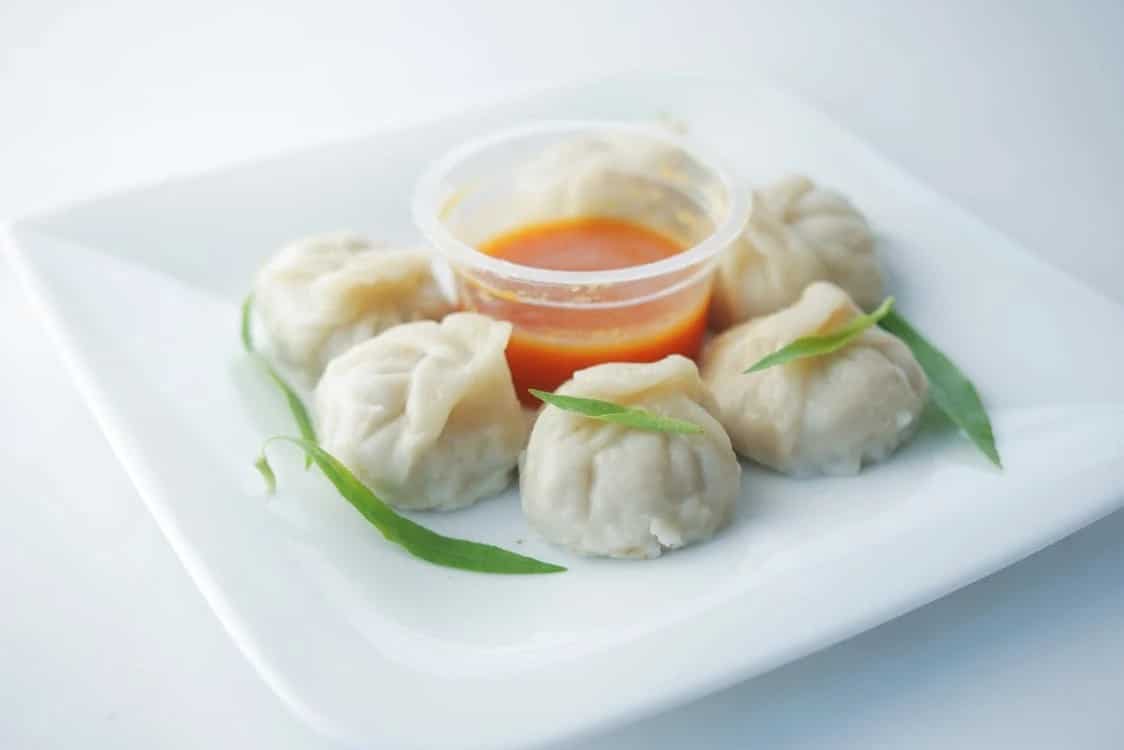
Image of Momos
No exploration of Arunachal’s culinary scene would be complete without the mention of Momos, the beloved dumplings known far and wide across India. Originally a staple of Tibetan cuisine, Momos have effortlessly made their home in Arunachal, with varied fillings catering to diverse palates.
Stuffed with an assortment of finely minced vegetables like cabbage, potato, and carrot or meats like chicken and mutton, momos are delicately wrapped in a thin covering made from wheat flour. Delightfully fluffy and packed full of flavour, Momos in Arunachal Pradesh is a must-try for anyone visiting this enchanting northeastern state.
Recipe
- Prepare dough by kneading flour with water until soft and smooth.
- Roll the dough into thin circles and fill with a mixture of finely chopped vegetables or meat, garlic, and spices.
- Fold and seal the edges of the dough to form dumplings.
- Steam the momos until cooked through, and serve with spicy chutney.
10. Apong
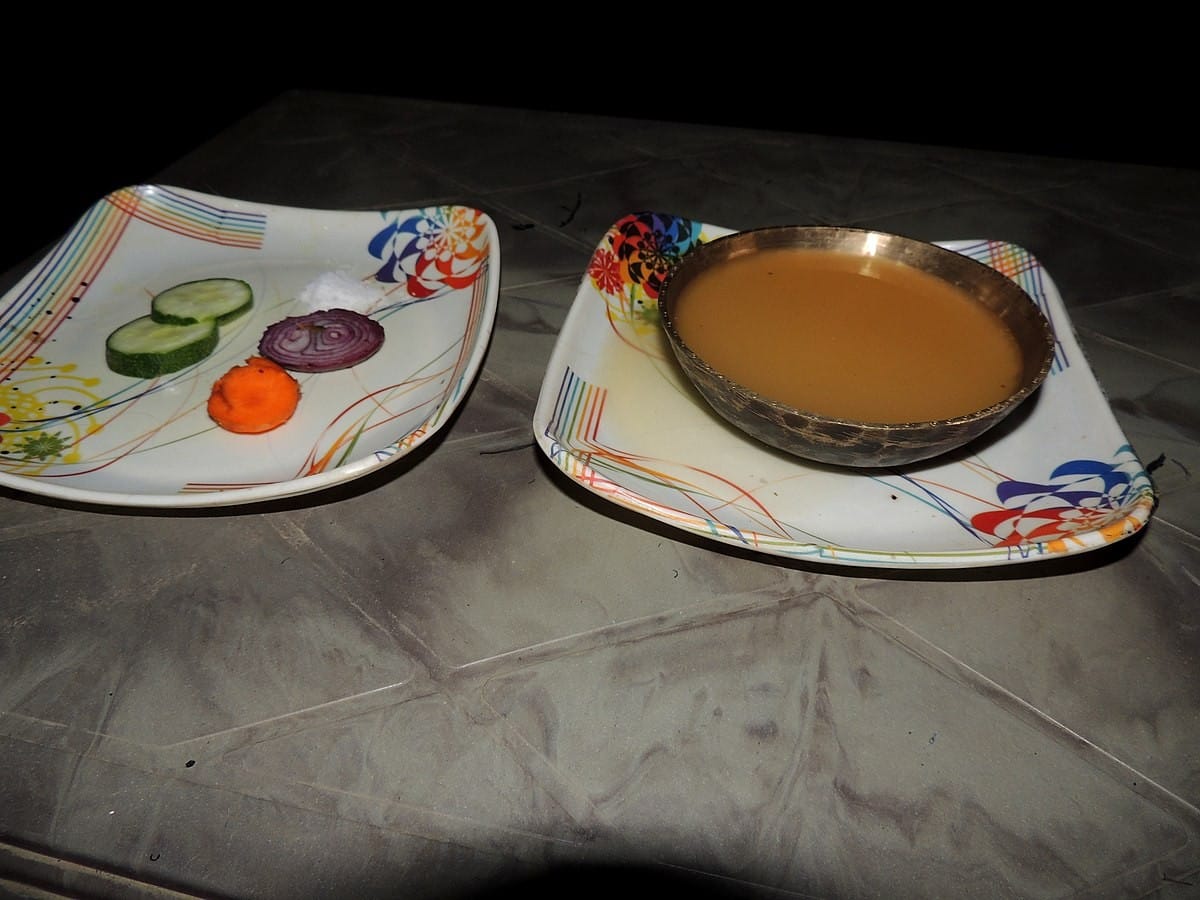
Image of Apong
To truly get a taste of Arunachali tradition, enjoying a pint of Apong, the local rice beer, is an absolute must. It’s homemade, organic and lacks any artificial elements, making it perfect for those looking for a light and more natural choice of beverage.
Highly revered by locals, this traditional drink isn’t just a popular choice for everyday consumption but also plays a significant role in ceremonies and festivities, forming an essential part of the cultural fabric of Arunachal Pradesh.
Unlike commercial beers, Apong has a distinct, slightly sweet taste owing to its preparation process that involves fermenting cooked rice mixed with a locally sourced fermenter. This results in a beverage that is light on the palate and imparts a delicate, airy aroma.
Indulging in a glass of Apong while savouring Arunachal’s gastronomy offers you an immersive experience into the heart of the state’s rich culture and heritage. It’s more than just a drink – it’s a culinary tradition that has survived countless generations, standing proud as a symbol of Arunachal Pradesh’s enduring heritage.
Recipe
- Clean and ferment rice with yeast culture for several days.
- Once fermented, boil the rice in water and allow it to cool.
- Strain the liquid to extract the rice beer.
- Serve Apong fresh and chilled as a traditional drink.
Conclusion
Diving deep into the essence of Arunachal Pradesh, you will find that food is not only a means of sustenance but also a way to celebrate and commemorate its rich cultural diversity. The cuisine is a confluence of varied tribal influences, distinguished by their preference for ingredients found in nature. Exploring Arunachal Pradesh and indulging in its gastronomy is an adventure in itself. Whether it’s the smoky nuances in the rice, the tantalising heat in the chutneys or the subtle sweetness in their locally brewed beer, every dish is a testament to the state’s respect for its natural bounty and ancient traditions. For more such dishes, visit Awesomecuisine.
Frequently Asked Questions
What are the ingredients used in Arunachal cuisine?
The food of Arunachal Pradesh mainly relies on staple ingredients like rice, meats (especially pork and beef), bamboo shoots, local herbs, and vegetables. This is quite similar to Sikkimese cuisine. Fermented soya bean and cheese made from yak or cow’s milk are common in many dishes.
What are some of the popular food festivals in Arunachal Pradesh?
Celebrations such as Solung (Adi Tribe), Losar (Monpas), Boori Boot, and Si-Donyi (Tagin tribe), among others, see various traditional dishes prepared as part of the festivities, showcasing the richness of Arunachali cuisine.
What are some of the popular vegetarian dishes in Arunachal Pradesh?
Pehak, a spicy chutney made from fermented soya beans, and Chura Sabzi, a curry made from fermented cheese, are popular vegetarian dishes. Also, dumplings or Momos with vegetable stuffing are a favourite among vegetarians.
What is the famous sweet dish of Arunachal Pradesh?
Koat Pitha is a famous sweet dish from Arunachal Pradesh. Made by frying a batter of bananas, jaggery, and flour in mustard oil, these doughnut-like treats feature a mix of sweet flavours along with a distinct taste from the mustard oil.


